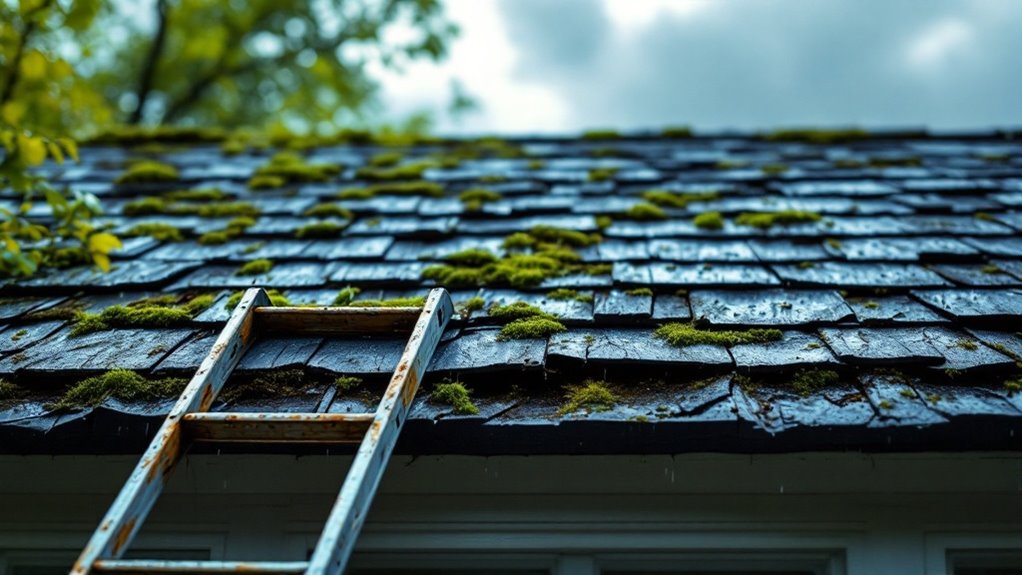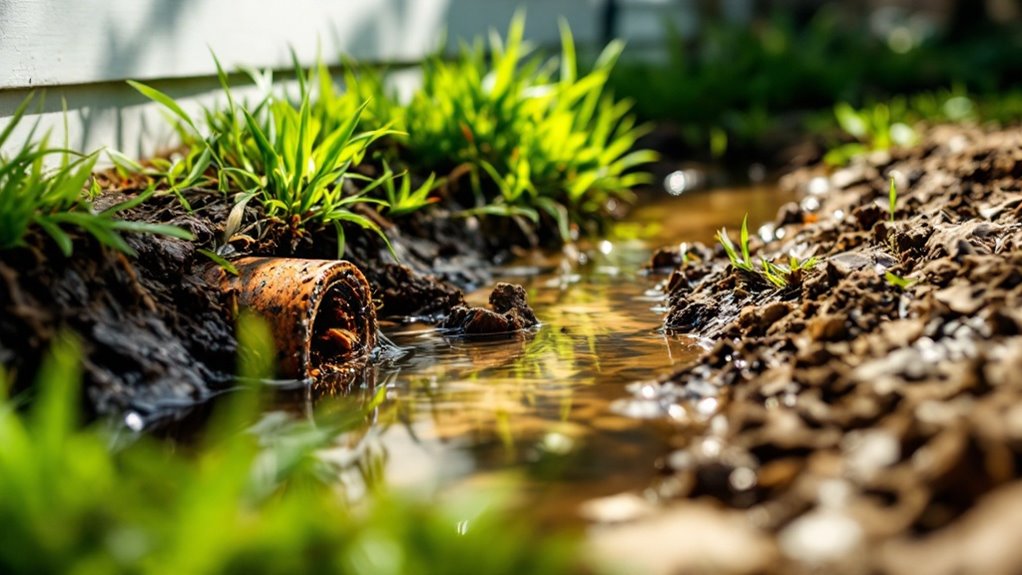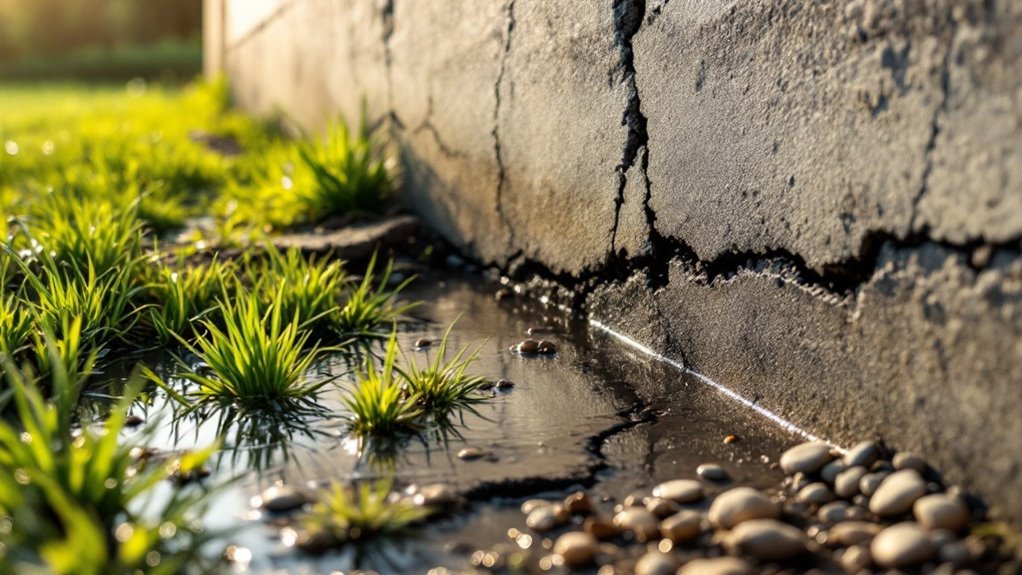Water damage can sneak up on you, often leading to costly repairs and significant stress. You might think a small leak isn’t a big deal, but it can quickly escalate. Understanding the top causes of water damage is crucial for protecting your home. From leaky roofs to appliance malfunctions, there are preventative measures you can take. Let’s investigate these issues and see how you can safeguard your home effectively.
Key Takeaways
- Regularly inspect roofs for missing shingles and cracked flashing to prevent leaky roofs and water stains on ceilings or walls.
- Monitor and maintain indoor pipe conditions to avoid burst and leaky pipes, especially in unheated areas during freezing temperatures.
- Ensure proper drainage by keeping gutters clean and grading yards away from the home to prevent flooding and water stagnation.
- Use exhaust fans and dehumidifiers to combat poor ventilation and excessive indoor humidity, reducing the risk of mold growth.
- Avoid drying clothes indoors to minimize humidity levels, which can lead to mold, mildew, and damage to furniture.
Leaky Roofs

A leaky roof can turn your home into a water-damaged nightmare if you’re not careful. It often starts with small issues, like missing shingles or cracked flashing, and can escalate quickly. You might notice water stains on your ceiling or walls, which are clear signs that moisture is getting in. Regular inspections can help you catch these problems early. Make it a habit to check your roof after storms or heavy winds. If you spot any damage, address it immediately by patching leaks or hiring a professional. Don’t forget about gutter maintenance, too; clogged gutters can lead to water pooling on your roof, worsening leaks. Additionally, consider scheduling roof inspections at least twice a year to ensure ongoing protection against potential leaks. Protect your home by staying proactive and informed about your roof’s condition.
Burst Pipes
Burst pipes can cause significant water damage if not addressed quickly. You’ll want to recognize the common causes and signs of damage to protect your home. Let’s investigate some prevention tips to keep your plumbing in check. Regularly inspecting your plumbing system is essential to prevent issues that could lead to bursts.
Common Causes Explained
When temperatures drop, pipes can freeze, leading to a burst that causes significant water damage. This often happens in unheated areas like basements or attics, where cold air can easily infiltrate. If you notice drafts or cold spots, it’s a good idea to insulate exposed pipes. Furthermore, corrosion and wear can weaken pipes over time, making them more susceptible to bursting. Regular maintenance, like checking for leaks and replacing old pipes, can help prevent issues. Don’t forget about water pressure; excessive pressure can strain pipes and cause them to fail. By keeping an eye on these common causes, you can protect your home and avoid the costly consequences of water damage from burst pipes. Additionally, installing emergency valves provides quick access to shut off water flow, minimizing damage in case of a burst.
Signs of Damage
You might notice several signs that indicate a burst pipe in your home. One of the most obvious signs is water pooling on your floor, especially in areas where plumbing runs. Check your walls and ceilings for water stains or discoloration, which can signal leaks behind them. You may also hear the sound of running water even when no taps are on, indicating a potential problem. Furthermore, if your water pressure drops suddenly, it could mean a pipe has burst. Finally, musty odors or mold growth can develop if water remains trapped. If you spot any of these signs, it’s essential to act quickly to minimize damage and get professional help.
Prevention Tips
Noticing signs of water damage, such as stains or musty odors, can be alarming, but taking steps to prevent burst pipes can save you from future headaches. First, keep your home at a consistent temperature, especially during winter months. Insulate pipes in unheated areas, like basements and attics, to protect them from freezing. Regularly check for leaks and corrosion, as these can weaken pipes over time. Drain outdoor hoses and shut off valves before the cold weather hits. Furthermore, consider installing a smart water monitor that alerts you to leaks immediately. Finally, if you’re going away for an extended period, ask someone to check on your home to catch any potential issues before they escalate.
Flooding
Although flooding can occur unexpectedly, its consequences are often devastating, leading to significant water damage in homes and businesses. Heavy rains, melting snow, or storm surges can cause rivers and lakes to overflow, impacting areas you might think are safe. To protect your property, stay informed about local weather forecasts and flood warnings. If you live in a flood-prone area, consider installing flood barriers and maintaining proper drainage around your home. Furthermore, raise electrical systems and appliances to reduce damage risk. Having a sump pump can help manage excess water during heavy rains. Finally, verify your insurance policy covers flooding, as this can save you from hefty repair costs in the aftermath of a disaster. Stay proactive to safeguard your space.
Poor Drainage

When heavy rainfall occurs, poor drainage can quickly turn into a major problem, leading to water pooling around your property and causing damage. To prevent this, start by ensuring your gutters and downspouts are clean and free of debris. Clogged gutters can overflow, directing water toward your foundation. You should likewise grade your yard to slope away from your home, allowing water to flow naturally instead of stagnating. Installing drainage systems like French drains can help redirect excess water. Regularly check for signs of erosion or pooling in your yard and address them promptly. By taking these proactive steps, you can maintain proper drainage and protect your property from potential water damage.
Appliance Malfunctions
Appliance malfunctions can unexpectedly lead to significant water damage in your home, especially if you’re not vigilant. Dishwashers, washing machines, and refrigerators can develop leaks or break down without warning. Regularly check hoses and connections for wear and tear, and replace them as needed. It’s additionally smart to clean your appliances regularly to prevent clogs and buildup. Consider using water leak detectors that alert you to issues before they escalate. If you notice dampness or unusual sounds, don’t ignore them; investigate right away. By staying proactive and addressing minor issues promptly, you can save yourself from costly repairs and extensive water damage. Remember, a little maintenance goes a long way in protecting your home.
Foundation Cracks

Since your home’s foundation is vital for its stability, cracks can signal serious problems that may lead to water damage. Even small cracks can allow water to seep in, causing mold growth and structural issues. To prevent this, regularly inspect your foundation for any signs of damage. Look for vertical or horizontal cracks, and address them immediately. Verify your gutters are clean and direct water away from your foundation to minimize erosion. Additionally, maintain proper drainage in your yard to prevent water pooling near your home. If you notice significant cracks or shifting, consult a professional for a thorough assessment. Taking these steps can help protect your home against the costly consequences of foundation-related water damage.
Humidity and Condensation
Humidity and condensation can wreak havoc in your home if you’re not careful. Poor ventilation often leads to excessive indoor humidity, creating the perfect conditions for water damage. It’s vital to recognize these issues early to protect your space.
Poor Ventilation Issues
When your home lacks proper ventilation, it can lead to serious issues like excess humidity and condensation. Stale air gets trapped, causing moisture to build up, which can encourage mold growth and damage your walls and ceilings. To prevent these problems, guarantee your home has adequate airflow. Open windows when weather permits, use exhaust fans in kitchens and bathrooms, and consider installing a whole-house ventilation system. Regularly check and clean vents to keep them clear. If you notice condensation forming on windows or walls, it’s a sign you need to improve ventilation. By taking these steps, you’ll create a healthier environment and protect your home from water damage caused by poor ventilation.
Excessive Indoor Humidity
Poor ventilation can lead to excessive indoor humidity, which greatly impacts your home. High humidity levels can cause mold growth, damage walls, and warp furniture. To prevent these issues, you need to monitor and manage indoor humidity levels effectively.
Here’s a quick guide to help you:
| Cause | Sign of Excessive Humidity | Prevention Method |
|---|---|---|
| Poor ventilation | Musty odors | Use exhaust fans |
| Cooking and showering | Condensation on windows | Use a dehumidifier |
| Leaky pipes | Mold growth | Fix leaks promptly |
| Houseplants | High moisture in air | Limit number of plants |
| Drying clothes indoors | Warping furniture | Dry clothes outside |
Conclusion
By staying proactive, you can protect your home from water damage. Regularly inspect your roof, maintain your pipes, and guarantee proper drainage. Clean your gutters, address appliance issues promptly, and monitor humidity levels. With these simple steps, you can prevent leaks, stop flooding, and avoid costly repairs. Remember, it’s not just about fixing problems; it’s about preventing them. Safeguard your home today, safeguard your peace of mind tomorrow, and safeguard your investment for years to come.
